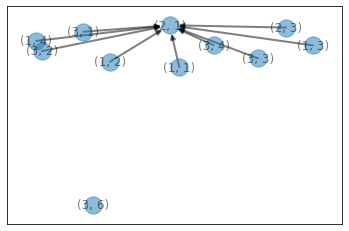In [1]:
1
2
3
4
5
import sys, random
sys.path.append("/home/swyoo/algorithm/")
from typing import List
import numpy as np
from utils.verbose import visualize_ds, logging_time
1254. Number of Closed Islands
Let $m, n$ be grid shape.
DFS + Disjoint Set(or Union Find)
Idea
- Remove lands connected to edges by re-marking grid elements.
- Union all grid except for water.
- Count all representatives.
The time complexity is $O(mn\alpha)$
In [2]:
1
2
3
4
5
6
7
8
9
10
11
12
13
14
15
16
17
18
19
20
21
22
23
24
25
26
27
28
29
30
31
32
33
34
35
36
37
38
39
40
41
42
43
44
45
46
47
48
49
50
51
52
53
54
55
56
57
58
59
60
61
62
63
64
class Solution1:
@logging_time
def closedIsland(self, grid: List[List[int]], show=False) -> int:
par, rnk = {}, {}
def find(x):
if x not in par:
par[x] = x
rnk[x] = 0
return par[x]
if x != par[x]:
par[x] = find(par[x])
return par[x]
def union(x, y):
x, y = find(x), find(y)
if x == y: return
if rnk[x] > rnk[y]:
x, y = y, x
par[x] = y
if rnk[x] == rnk[y]:
rnk[y] += 1
def adj(i, j):
for x, y in [(i - 1, j), (i + 1, j), (i, j - 1), (i, j + 1)]:
if 0 <= x < len(grid) and 0 <= y < len(grid[0]) and not grid[x][y]:
yield x, y
seen = set()
def rmland(i, j):
seen.add((i, j))
grid[i][j] = 1
for x, y in adj(i, j):
if (x, y) not in seen:
rmland(x, y)
for i in range(len(grid)):
if (i, 0) not in seen and not grid[i][0]:
rmland(i, 0)
if (i, len(grid[0]) - 1) not in seen and not grid[i][len(grid[0]) - 1]:
rmland(i, len(grid[0]) - 1)
for j in range(len(grid[0])):
if (0, j) not in seen and not grid[0][j]:
rmland(0, j)
if (len(grid) - 1, j) not in seen and not grid[len(grid) - 1][j]:
rmland(len(grid) - 1, j)
if show: print(np.array(grid))
for i in range(len(grid)):
for j in range(len(grid[0])):
if not grid[i][j]:
find((i, j))
for x, y in adj(i, j):
union((i, j), (x, y))
if show: visualize_ds(par)
ans = 0
for i in range(len(grid)):
for j in range(len(grid[0])):
if not grid[i][j] and (i, j) == find((i,j)):
ans += 1
return ans
sol1 = Solution1()
In [3]:
1
2
grid = [[1,1,1,1,1,1,1,0],[1,0,0,0,0,1,1,0],[1,0,1,0,1,1,1,0],[1,0,0,0,0,1,0,1],[1,1,1,1,1,1,1,0]]
sol1.closedIsland(grid, show=True, verbose=True)
1
2
3
4
5
6
[[1 1 1 1 1 1 1 1]
[1 0 0 0 0 1 1 1]
[1 0 1 0 1 1 1 1]
[1 0 0 0 0 1 0 1]
[1 1 1 1 1 1 1 1]]

1
2
WorkingTime[closedIsland]: 191.04004 ms
1
2
DFS
Idea
seen is very important!.
- Remove lands connected to edges by re-marking grid elements and add all grid to
seen. - add all lands to
seen.
notice that once dfs(i, j) marks all lands connected to (i, j) except for waters.
In [4]:
1
2
3
4
5
6
7
8
9
10
11
12
13
14
15
16
17
18
19
20
21
22
23
24
25
26
27
28
29
30
31
32
33
34
35
36
37
38
39
40
class Solution2:
@logging_time
def closedIsland(self, grid: List[List[int]], show=False) -> int:
def adj(i, j):
for x, y in [(i - 1, j), (i + 1, j), (i, j - 1), (i, j + 1)]:
if 0 <= x < len(grid) and 0 <= y < len(grid[0]) and not grid[x][y]:
yield x, y
seen = set()
def dfs(i, j, rmland=False):
seen.add((i, j))
if rmland: grid[i][j] = 1
for x, y in adj(i, j):
if (x, y) not in seen:
dfs(x, y)
for i in range(len(grid)):
if (i, 0) not in seen and not grid[i][0]:
dfs(i, 0, rmland=True)
if (i, len(grid[0]) - 1) not in seen and not grid[i][len(grid[0]) - 1]:
dfs(i, len(grid[0]) - 1, rmland=True)
for j in range(len(grid[0])):
if (0, j) not in seen and not grid[0][j]:
dfs(0, j, rmland=True)
if (len(grid) - 1, j) not in seen and not grid[len(grid) - 1][j]:
dfs(len(grid) - 1, j, rmland=True)
if show: print(np.array(grid))
ans = 0
for i in range(len(grid)):
for j in range(len(grid[0])):
if (i, j) not in seen and not grid[i][j]:
ans += 1
dfs(i, j)
return ans
sol2 = Solution2()
In [5]:
1
2
3
m, n = 1000, 1000
grid = [[random.randint(0, 1) for i in range(m)] for j in range(n)]
print(np.array(grid))
1
2
3
4
5
6
7
8
[[1 1 0 ... 1 0 0]
[1 0 1 ... 1 1 0]
[1 0 0 ... 0 1 1]
...
[0 0 0 ... 0 1 1]
[0 0 1 ... 1 0 0]
[0 1 0 ... 1 0 1]]
In [6]:
1
2
3
4
ans1 = sol1.closedIsland(grid, verbose=True)
ans2 = sol2.closedIsland(grid, verbose=True)
print(ans1, ans2)
assert ans1 == ans2
1
2
3
4
WorkingTime[closedIsland]: 2841.18605 ms
WorkingTime[closedIsland]: 1092.00549 ms
64681 64681


Leave a comment